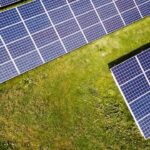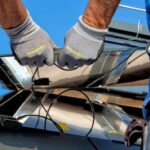Mitigating Wind-Related Damages in Solar Power Plants Worldwide
The global solar energy industry has witnessed substantial growth over the years, with solar power plants contributing significantly to the renewable energy landscape. However, an often-overlooked threat to solar power plants is the damage caused by strong winds. Recent incidents in various regions highlight the need for solar power plant owners, operators, and construction firms to prioritize wind resistance in their designs and maintenance practices.
Wind-Related Incidents
On February 1, 2023, a distributed solar power plant in Jiangsu’s Muyang County, China, fell victim to powerful winds, resulting in extensive damage to the facility. Local meteorological reports indicated that the day was marked by northeast winds at levels 4 to 5, with gusts reaching 6 to 7 on the Beaufort scale. Experts believe the accident may have been exacerbated by the use of expansion screw structures in the solar panels. However, many argue that the root cause lies in inadequate wind-resistant standards, particularly in coastal provinces like Jiangsu, where typhoons often exceed Category 12 during the typhoon season. Therefore, enhancing wind resistance should be considered from the project’s initial design phase.
This specific solar power plant lacked fixed foundations or cement piers, suggesting either substandard construction practices or cost-cutting measures by the owner. Given Jiangsu’s coastal location and frequent typhoons in the summer and fall, wind resistance should have been a primary consideration during the plant’s design phase.
Similarly, in November of the previous year, a solar project operated by China Petrochemical Corporation (Sinopec) suffered extensive damage due to adverse weather conditions. Nearly a hundred megawatts of solar panels were toppled by strong winds. The incident was attributed to two main factors: extreme weather conditions and inadequate structural strength of the support frames. The local weather agency had issued a red wind warning for the area on November 27, 2022, with gusts exceeding 13 on the Beaufort scale. It was clear that the project’s design did not account for the potential impact of extreme weather in the region.
Incidents of solar power plants being damaged by high winds were not limited to these two locations. Similar events occurred in Shanxi’s Yuncheng and Jincheng, as well as Shandong’s Yantai, around the Chinese New Year period. Industry experts emphasize that wind resistance design is essential, especially during seasons with frequent strong winds, like spring and summer.
Key Considerations for Wind Resistance
Inspect Rust on Support Structures: Inadequate quality of support structure components can lead to long-term stability issues. Rust or component detachment can cause support structures to loosen, affecting the tilt of solar panels, leading to reduced energy generation, or even complete structural failure. Regular inspections are crucial.
Adequate Ballast Weight: In flat-roof solar projects, most designs use concrete blocks for ballast weight to avoid damaging the roof structure. The heavier the ballast, the larger the frictional force between the blocks and the roof, providing greater wind resistance. Insufficient ballast weight can result in solar panel displacement and eventual collapse during strong winds.
Preventive Measures
- Secure Fasteners: Before the arrival of severe weather, ensure that screws, bolts, and fasteners are securely tightened. Check for any loosening of mid-clamps and end-clamps, and promptly address any issues.
- Install Wind Bracing: In solar power plants without added wind protection, consider installing and securing wind bracing to prevent support frame movement. Additionally, firmly anchor ground-based installations.
- Verify Fixture Stability: For solar power plants using hooks and fixtures for installation, regularly inspect their stability. In the case of flat-roof installations, consider using 2mm² iron wire to bundle and secure rows of panels facing the wind.
- Inspect Electrical Components: Ensure the insulation and sealing of all electrical equipment in the solar power plant. Verify the proper connection of AC and DC terminals. In flood-prone areas, consider relocating inverters to higher ground or implementing protective measures.
Conclusion
The recent incidents of wind-induced damage to solar power plants underscore the importance of wind resistance in the design and maintenance of such facilities. Solar power plant owners, operators, and construction firms should take proactive steps to prevent wind-related incidents, safeguarding both their investments and the future of clean energy production. By adhering to these guidelines and prioritizing wind resistance, the solar energy industry can continue to thrive and contribute to a sustainable future for all.



